
What makes you stop scrolling through an article, open up a social media app and hit the share button?
Is it logic, emotion, or something else?
Turns out, there’s more to social sharing than just measuring metrics: Psychology.
The strange nature of our brains is the reason we hotly debate the color of a dress or why we freely and emotionally share a post by a grieving widow after the death of her husband or why we feel an urgent need to pass on that video of the ice-cream eating dog to our animal-loving father-in-law. (Guilty!)
It’s not logic that guides those shares; it’s emotion. How else can you explain 8.2 million hits to a YouTube music video that a majority of people claim to have not liked?
If you want your content to be shared and shared regularly, understanding the “why” and “how” behind social shares can go a long way in showing you how to craft the perfect post for your audience. In order to do so, you might want to:
- Understand why people share content
- Know what kind of content they’re more likely to share
- Set about the task of creating content that satisfies those emotions
We’ve put together a few handy tips on how to understand what your audience wants and start the process of delivering it to them.
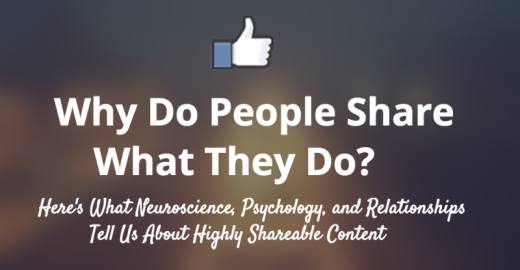
5 Reasons Why People Share to Social Media
1. Neuroscience: We share to entertain, inspire, and be useful
Even though social media does have a tendency of having people focus on themselves, the primary reason that people share things on their Facebook pages or Twitter feeds, research shows, is to be useful to others.
In a 2013 study conducted by psychologists at UCLA, the researchers were, for the first time, able to determine which brain regions are associated with ideas that become contagious and which regions are associated with being an effective communicator of ideas.
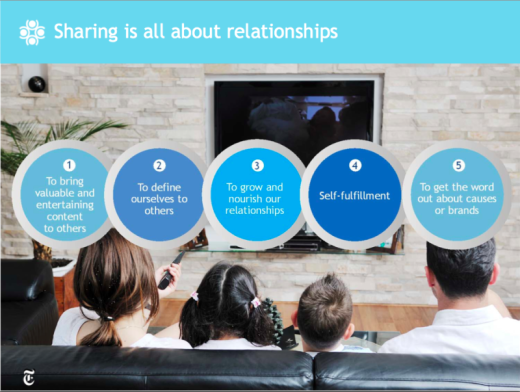
The TPJ or the temporoparietal junction is this area of the brain that lit up during functional magnetic resonance imagine (fMRI) brain scans when people were first exposed to new ideas that they would later recommend.
Matthew Lieberman, a UCLA professor of psychology and of psychiatry and biobehavioral sciences and author of the book Social: Why Our Brains are Wired to Connect, noted:
Our study suggests that people are regularly attuned to how the things they’re seeing will be useful and interesting, not just to themselves, but also to other people. We always seem to be on the lookout for who else will find this helpful, amusing or interesting, and our brain data are showing evidence of that. At the first encounter with information, people are already using the brain network involved in thinking about how this can be interesting to other people. We’re wired to want to share information with other people. I think that is a profound statement about the social nature of our minds.
2. Psychology: We share to express who we really are
In 1986, psychologists Hazel Markus and Paula Nurius recognized that there is a disparity between our “now self” and our “possible self.”
In a paper they published at the time, they developed the concept of our possible selves:
- the ideal selves that we would like to become
- the selves that we could become, and
- the selves that we are afraid of becoming
This first self, the idealized version of ourselves is what we frequently tend to share on social media.
Whether or not this representation of our possible self is realistic or not is irrelevant, researchers note. The point is that we’re picturing in our minds this possible self that we are or may someday be and sharing information that fits in with this notion of who we are.
When we share in this mode, sometimes what we’re sharing is a sense of our ideal self and who we aspire to be. This is why some people share political commentary, outrage over particular issues, and success stories of people who they hope they can be like someday.
As the authors themselves so eloquently note:
Possible selves contribute to the fluidity or malleability of the self because they are differentially activated by the social situation and determine the nature of the working self-concept. At the same time, the individual’s hopes and fears, goals and threats, and the cognitive structures that carry them are defining features of the self-concept: these features provide some of the most compelling evidence of continuity of identity across time.
3. Community: To nurture our relationships
Whenever I see a funny comic about procrastination, I share it with my closest friend, a proud procrastinator. Whenever I see a funny dog video, I send it straight to my father-in-law, the animal lover.
Every time I see any of these things, I feel an immediate connection to those people. I think of them and feel the urge to share what I’ve found with them.
I’m not alone.
In a study undertaken by The New York Times Customer Insight Group in conjunction with Latitude Research titled “The Psychology of Sharing: Why Do People Share Online?” 78 percent of respondents said that they shared information online because it let them stay connected to people they may not otherwise stay in touch with.
Further, 73 percent of them said they shared information because it allowed them to connect with others who shared their interests.
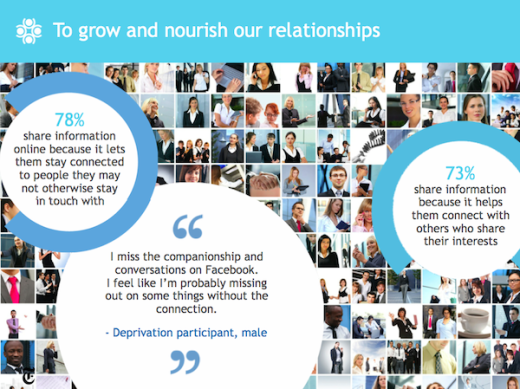
4. Motivation: To feel more involved
In my days of daily journalism, an editor at a local newspaper once told me his fix for a slow news day.
Dogs and babies.
“They’re cute,” he would say. “They pull at your heartstrings. No one can resist a cuddly dog or a cute baby. Preferably both together.”
The medium may have changed but the message hasn’t. People still love cuddly dogs, cute babies, preferably both together.
In fact, as far back as fifty years ago, studies were being undertaken to see why people talked about brands and coming to the same conclusions that we are today. In 1966, in a study reported on by the Harvard Business Review, the researcher Earnest Dichter found that 64 percent of sharing is about the sharer themselves.
He noted that there were four motivations for a person to communicate about a brand.
- The first (about 33 percent of the time) was because of product-involvement, that is the experience was so good, unique, or new that it had to be shared.
- The second (about 24 percent) was self-involvement, that is, to gain attention by showing people that you were part of an exclusive club of buyers or had inside information.
- The third (around 20 percent) was other-involvement, that is wanting to help out and express caring or friendship.
- And finally, the fourth (also around 20 percent) was message-involvement, that is, the message was so wonderful or funny or brilliant that it deserved to be shared.
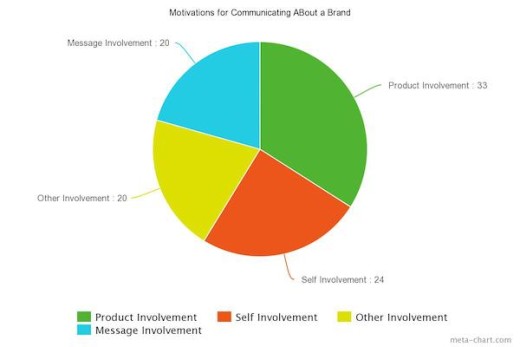
5. Altruism: To get the word out about specific causes
In the New York Times Customer Insight Group report, 84 percent of respondents said they share because “it is a way to support causes or issues they care about.”
In fact, the report further goes to show that 85 percent of people say reading other people’s responses helps them understand and process information and events. So not only do we share information about the causes that are dear to us, but we respond to causes that are dear to other people if they take the time to share that information with us through social media.
Remember the ALS Ice Bucket challenge?
What People Share and How to Make Your Content Go Viral
In a research study titled “Why Content Goes Viral,” assistant professor of marketing at the Wharton School of Business Jonah Berger (who you may also know as the author of the book Contagious) and co-author Katy Milkman looked at 7,000 articles published at The New York Times to see which ones got the most views and social shares and why. The goal of the study was to document what makes content go viral and how to replicate those findings to create viral content.
This infographic from CoSchedule does a great job capturing some of the findings of the study:
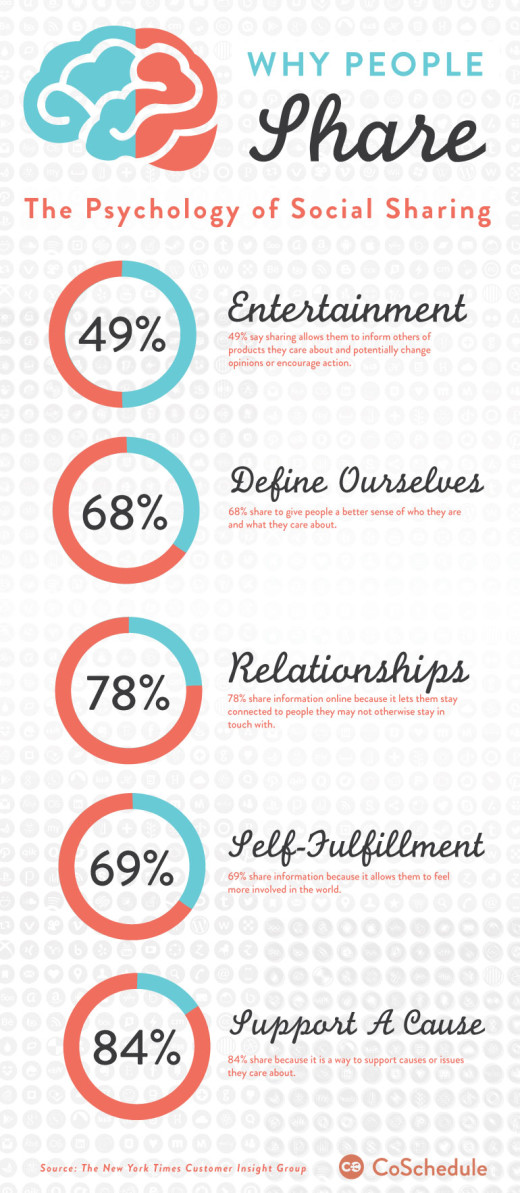
The researchers from the study came up with three key ideas based on their findings:
1. Positive content trumps negativity
You may not know it from your Facebook feed, but Berger and Milkman found that positive content and stories were far more likely to be shared and to go viral than negative news stories.
Are you surprised by this finding? Most people are. But the reason bad news sticks in our minds more than good news is because of our brain’s “negativity bias.” Human brains are wired to react with greater sensitivity to bad news and feedback than anything positive, and so you may see and hear a hundred pieces of positive news throughout your day but remember that one news story about a sick child. It also explains why you remember an insult or attack decades after all the compliments and accolades have been forgotten.
Yet, research shows that if you want your content to go viral and reach more people, it has more of a likelihood of doing so if it comes in a positive package.
How to create positive content
Try framing events in a positive context. Research shows that superlatives can be super effective in headlines. For example:
- Best
- Biggest
- Greatest
As Courtney explains in this post, Buffer’s focus on positivity and happiness means that we turn this technique inside out with posts such as 10 Things To Stop Doing Today to Be Happier, Backed by Science.
2. Content that evokes high arousal emotions does better
This is probably not quite as surprisingly, but Berger and Milkman found that the more a piece of content could evoke a high-arousal emotion such as awe, anger, anxiety, fear, sadness, humor, or wonder, the better its chances of being shared repeatedly and going viral.
That’s why counter-intuitive takes on issues do so well and why articles that make you angry are often the ones that you forward to friends.
In fact, this is backed up by our own research here at Buffer. In a recent experiment, we found that one of the key things that makes images go viral is an element of surprise.
In the NYT study, the articles that scored highly on different dimensions were:
Emotionality:
- Redefining Depression as Mere Sadness
- When All Else Fails, Blaming the Patient Often Comes Next
Positivity:
- Wide-Eyed New Arrivals Falling in Love with the City
- Tony Award for Philanthropy
(Low-scoring)
- Web Rumors Tied to Korean Actress’s Suicide
- Germany: Baby Polar Bear’s Feeder Dies
Awe:
- Rare Treatment Is Reported to Cure AIDS Patient
- The Promise and Power of RNA
Anger:
- What Red Ink? Wall Street Paid Hefty Bonuses
- Loan Titans Paid McCain Adviser Nearly $2 Million
Anxiety
- For Stocks, Worst Single-Day Drop in Two Decades
- Home Prices Seem Far From Bottom
Sadness
- Maimed on 9/11, Trying to Be Whole Again
- Obama Pays Tribute to His Grandmother After She Dies
How to create emotional content
One of the driving forces for emotional content is someone’s first touch with your content: the headline.
There are some amazingly useful tools out there to help ensure your headline packs the right emotional punch.
- CoSchedule Headline Analyzer – This fantastic tool will quickly tell you how to improve your headlines by scoring you on your word choices. It takes a look at the words in your headline and sorts them into four categories: common, uncommon, emotional, and power. The more emotional and power words, the better your headline.
- Advanced Marketing Institute Headline Analyzer – This free tool analyzes your headlines to determine theEmotional Marketing Value (EMV) score of your headline. The tool analyzes the total number of EMV words in relation to the total number of words in the headline and comes up with a score.

3. Practical and useful information wins out every time
Finally, no surprise to anyone who has read and shared our own content here at Buffer (thank you, by the way!), content that helps you solve a problem, gives you actionable tips, and shows you practical strategies for living your life is destined for success as long as it can meet the needs of a large number of people and do it in a unique and interesting way.
How to create practical, useful content
In her article Transforming Content From Lifeless to Actionable, blogger Amanda Gallucci offers the following tips on how to do this effectively. She writes:
- Involve your audience: This might involve comments, surveys, or questions, but most importantly, referencing your audience in the content itself. Gallucci suggests creating interactive modules that readers can use within the content itself.
- Link your research to applications: Research and numbers are great, but showing how users can apply that research to their lives or solving their problems can be a great way of providing value.
- Look beyond your industry: When it comes to inspiration, don’t let your industry experts be the only thing that guides you towards creating useful content that is a match for your audience. If your business focuses on finances and numbers, considering learning from creative businesses, and vice versa.
- State the intended outcome early on: Whenever you’re creating a piece of content, it’s always a good idea to state, right upfront, what the visitor or reader will get if he or she reaches the end of the article. Make a promise to your reader to teach or educate them, and then keep it.
- Think ahead: One of the best things you can do for your content is to have an editorial calendar that guides your day-to-day content decisions and gives you the flexibility and room to comment on industry-specific events and anniversaries and give readers an analysis of any big news that comes up in your space.
So there you have it. Be positive, touch on some emotions, and be useful. The three keys to creating content that gets shared again and again. And again.
Over To You
I’d love to hear from you about your experiences with viral content. Have you ever had anything go massively viral? What did you learn from the experience?
Read Next: The science of viral content: Which emotions are shareable for different age groups and genders?
Image credit: Shutterstock
This post first appeared on Buffer.
Get the TNW newsletter
Get the most important tech news in your inbox each week.




